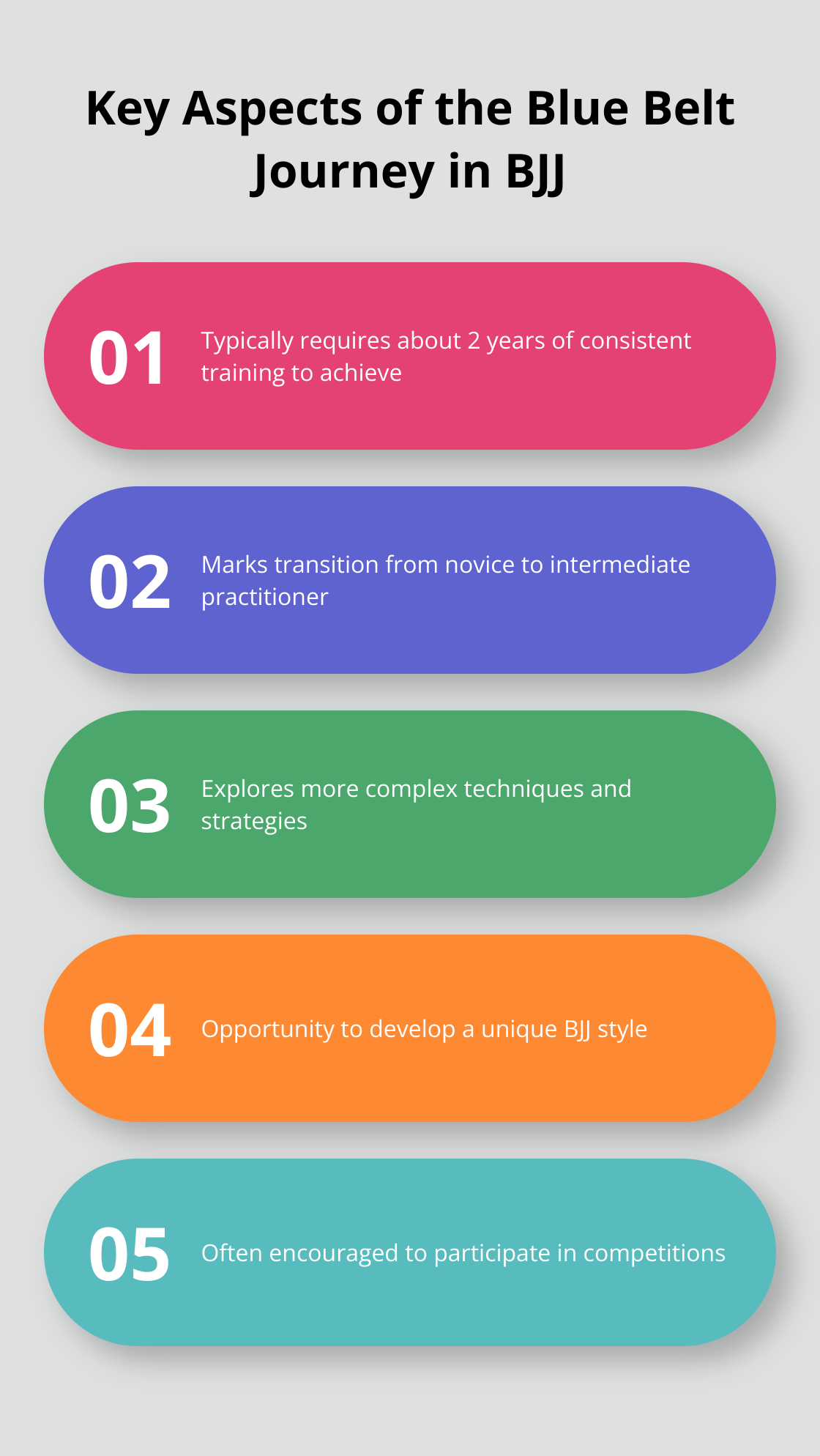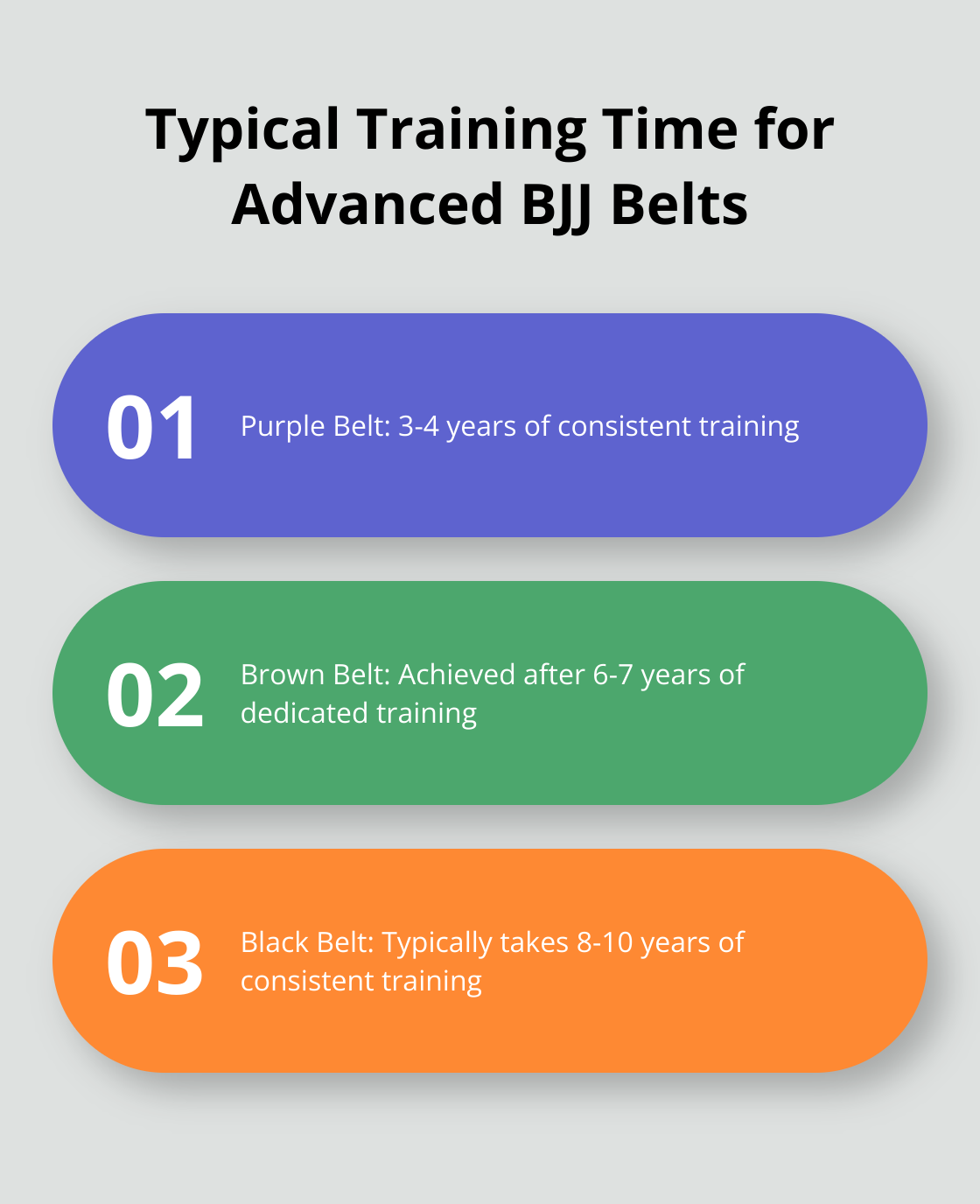At Jiu jitsu, we often get asked about the journey from white to black belt. The Jiu Jitsu belt ranking system is a fascinating aspect of our sport, marking progress and skill development.
This post will guide you through each belt level, highlighting key milestones and expectations along the way. Whether you’re just starting out or well on your path to mastery, understanding the BJJ belt progression can help you set goals and appreciate your growth in this challenging martial art.
White Belt: The Starting Point
Foundation of BJJ
The white belt stage marks the beginning of your Brazilian Jiu-Jitsu (BJJ) journey. This level lays the groundwork for your entire martial arts experience. The International Brazilian Jiu-Jitsu Federation (IBJJF) suggests three types of graduation systems based on Degrees and stripes for Kids, allowing academies to choose the one that best fits their program.

Mastering the Basics
As a white belt, your main focus should be on learning fundamental techniques. These include basic positions like guard, mount, and side control. You’ll also start to grasp essential submissions such as armbars, chokes, and leg locks. Don’t worry about advanced techniques yet. Instead, perfect your form and understand the principles behind each move.
Common Challenges
White belts often face several hurdles. One of the biggest is adapting to the physical demands of BJJ. You’ll likely experience muscle soreness and fatigue as your body adjusts to the new movements. Another common issue is feeling overwhelmed by the sheer volume of techniques to learn. Focus on small, consistent improvements rather than trying to master everything at once.
Mental Resilience
BJJ isn’t just about physical skills; it’s also a mental game. As a white belt, you need to develop patience and perseverance. You’ll be tapped out frequently (especially by more experienced practitioners). This can be frustrating, but it’s a vital part of the learning process. Use these experiences as opportunities to identify areas for improvement.
Progression to Blue Belt
The transition from white to blue belt is a significant milestone in your BJJ journey. It signifies that you’ve grasped the fundamental concepts and are ready to build upon this foundation. As you progress, you’ll notice improvements in your technique, stamina, and overall understanding of BJJ principles. This growth sets the stage for the next exciting phase of your training: the blue belt level.
Blue Belt: The First Major Milestone
Significance of the Blue Belt
Earning a blue belt in Brazilian Jiu-Jitsu (BJJ) marks a significant achievement. This milestone typically requires about two years of consistent training, according to the International Brazilian Jiu-Jitsu Federation (IBJJF). The blue belt represents the transition from novice to intermediate practitioner, showcasing a solid grasp of fundamental techniques and principles.
Advanced Techniques and Strategies
Blue belts explore more complex techniques and strategies. Practitioners learn intricate submissions, guard variations, and escapes. For example, blue belts might study the De La Riva guard or the berimbolo sweep. These advanced moves build upon the solid foundation established during the white belt phase.
Developing a Personal Style
The blue belt stage offers an exciting opportunity to develop a unique BJJ style. Practitioners identify techniques that complement their body type and personality. Some excel at guard play, while others prefer a top-heavy game. This period of experimentation helps blue belts find their niche within the sport.
Competition and Growth
Many BJJ schools encourage blue belts to participate in competitions. Tournaments provide valuable experience and help practitioners gauge their progress against peers. These competitive experiences often accelerate growth and highlight areas for improvement.
Time and Dedication
The journey through the blue belt rank requires significant time and dedication. Practitioners typically spend 2 years at this level, according to the IBJJF requirements. This extended period allows for deep learning and skill development (both physical and mental). As blue belts progress, they lay the groundwork for the advanced ranks that follow, setting the stage for the challenges and rewards of the purple belt.

Advanced Belts: Mastering the Art of BJJ
Purple Belt: The Technical Innovator
Purple belt practitioners typically have 3-4 years of consistent training, training 5-6 days a week with 1-2 week breaks not including holidays. This stage focuses on technique refinement and the development of a unique BJJ style. Purple belts often push the boundaries of their game through creative combinations and unorthodox moves.
A primary objective for purple belts is to gain a deep understanding of BJJ strategy. This involves not only mastering individual techniques but also learning to chain them together effectively in various scenarios. Many purple belts begin to specialize in specific areas of BJJ (such as leg locks or back attacks).
The International Brazilian Jiu-Jitsu Federation (IBJJF) requires purple belts to train for a minimum of 1.5 years before promotion to brown belt. However, the actual time at this level varies greatly depending on individual progress and dedication.
Brown Belt: The Emerging Leader
Brown belt signifies a high level of proficiency in BJJ, typically achieved after 6-7 years of dedicated training. At this stage, practitioners should possess a comprehensive understanding of BJJ techniques and concepts.
Brown belts often assume leadership roles within their academies, assisting in teaching classes and mentoring lower-ranked students. This teaching experience solidifies their own knowledge and improves their ability to break down complex techniques for others.
A significant aspect of the brown belt journey involves mastering the nuances of BJJ. This includes developing a keen sense of timing, pressure, and leverage. Brown belts work to perfect their favorite techniques and create seamless transitions between positions.
The IBJJF mandates a minimum of 1 year at brown belt before promotion to black belt. However, many practitioners spend 2-3 years at this level, honing their skills and preparing for the ultimate rank.
Black Belt: The Lifelong Student
Achieving a black belt in BJJ is a monumental accomplishment that typically takes 8-10 years of consistent training. However, earning a black belt marks the beginning of a deeper exploration of the art, not the end of the journey.
Black belts continue to refine their techniques and expand their knowledge. Many focus on giving back to the BJJ community through teaching, competing at high levels, or developing innovative training methods. The black belt rank also includes several degrees, each representing additional years of dedication and contribution to the art.
One of the most challenging aspects of being a black belt is maintaining humility and a student mindset. The best black belts never stop learning, always seeking to improve their skills and deepen their understanding of BJJ.
The time commitment required to progress through these advanced belts is substantial. Consistent training, often 3-5 times per week, is typically necessary to make steady progress. However, the rewards – improved physical fitness, mental resilience, and a deep sense of accomplishment – make the journey worthwhile for dedicated practitioners.

Final Thoughts
The Jiu-Jitsu belt ranking system represents a journey of growth, dedication, and personal development. Each rank brings new challenges and opportunities for learning, developing mental resilience, problem-solving abilities, and a deep understanding of the art. Patience and consistent training are essential to advance through the ranks, as progress in BJJ isn’t always linear and plateaus are common.
Every training session provides an opportunity to improve, regardless of your current belt level. We encourage you to embrace the challenges, learn from failures, and celebrate successes, no matter how small. The journey itself holds as much importance as reaching your destination (if not more).
Ready to start or continue your BJJ journey? We at Souza Grappling Co. offer a welcoming environment for practitioners of all levels. Our facility provides top-notch Jiu-Jitsu training, along with Muay Thai, Yoga, and Self-Defense classes. Join us and experience the transformative power of Brazilian Jiu-Jitsu for yourself.




